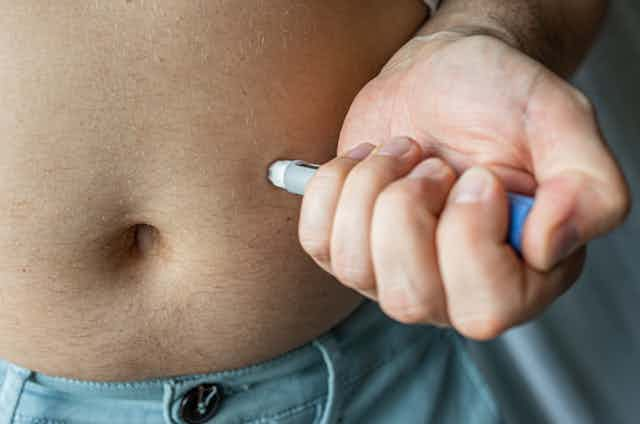Despite the effectiveness of the newer generation of anti-obesity drugs – called GLP-1 receptor agonists – few can tolerate them in the long run. A new study, published in the journal Obesity, reveals that of people prescribed weight-loss drugs, just 44% were still taking them after three months and only 19% after one year.
Greater adherence to these drugs, such as Wegovy, which make you feel fuller faster and longer, is associated with greater weight loss. So why do people not persist with it?
Actually, it’s not that unusual. Not persisting with medication is a well known phenomenon with other conditions, such as type 2 diabetes, chronic obstructive pulmonary disease and hypertension. Studies have shown that by the end of one year, almost half of the people on blood pressure pills stop taking them.
The willingness to keep taking medication can be influenced by the symptoms (or lack of) of the condition being treated; by aspects of the healthcare system (such as the ability to be seen by a doctor or the cost of medication); as well as by characteristics of the treatment itself (such as how frequently it needs to be taken, or how tolerable the side-effects are).
Indeed, the frequency of GLP-1 dosing has been shown to be important for people with diabetes. Those who take GLP-1 drugs once a week are more likely to stick with it than those who have a daily injection.
The potential side-effects of GLP-1 medication have attracted attention. In clinical trials, the proportion withdrawing from GLP-1 treatment ranges from 15% to 25%. About half of people who stopped taking the drug did so as a result of side-effects – mostly gastrointestinal problems.
Yet, on the whole, side-effects of GLP-1 drugs tend to be mild or moderate. Some people experience bouts of nausea in the first four weeks of using the drug, but this can become worse if the dose is escalated. Diarrhoea, constipation, fatigue and sulphurous burping can also occur.
However, it’s worth noting persistence with GLP-1 drugs appears much greater than with other weight loss drugs.
Clinical trials have shown that maximal weight loss with GLP-1 drugs is not achieved until about one year and it may be that some people wish to see a more rapid response. However, about 6% weight loss can be achieved within 12 weeks, which would be an incentive to persist with treatment.
There is a well reported global shortage of GLP-1 drugs. This has occurred partly due to the very success of these drugs, and the lack of availability may result in patients being unable to persist with the drug.
What happens when people stop taking the drug?
While there is some debate as to how sustainable GLP-1 drugs are for weight loss, a more pertinent question is what happens when people stop this treatment.
These drugs may be heralded as gamechangers when it comes to getting people to lose weight, but several trials have shown clear weight regain when treatment is withdrawn. For example, participants who withdrew once-a-week treatment with Wegovy in the international Step-1 trial, regained more than half the weight lost over the course of a year.
A more recent study showed that those who stopped treatment with Mounjaro (another GLP-1 drug) similarly regained around 60% of their lost weight.
The take home from these studies, and others like them, is that weight loss can be maintained, provided you don’t stop the medication.
We have long known that, regardless of the means of losing weight, once the intervention is stopped, it is common for people to put weight back on.
Several biological and energetic changes happen as a result of weight loss that may make you healthier, but equally drive you to restore your lost weight – as discussed in a previous Conversation piece.
Yet the way these new weight-loss drugs work may mean the likelihood of putting lost weight back on is even higher. The artificial GLP-1 you inject is not the same as your own homegrown GLP-1, also known as “endogenous GLP-1”.
Ordinarily, you release GLP-1 after a meal, but it doesn’t last long because it is rapidly broken down.
In contrast, injecting artificial GLP-1 gives you a much higher dose, that also lasts a lot longer. Equivalent to [ten times] normal active GLP-1. Such levels are only ever seen naturally right after eating a massive blowout meal, but with these drugs are present in the blood all the time.

Despite this being comparable to you overdosing on GLP-1, you may become no less sensitive to its effects, as seen in animal studies, at least. All good news as this will not only make you feel full but sustain this fullness despite your body’s attempts to make you hungrier.
However, sustaining such high levels of “fake” GLP-1 could cause you to produce less of your own endogenous GLP-1.
Cold turkey
All this is no issue, presuming you continue keeping GLP-1 levels artificially high. But like any addict will tell you, bad things can happen when you go “cold turkey”.
In this case, when you stop taking these drugs, active GLP-1 levels will go off a cliff. No longer shackled, hunger and appetite may well return with a vengeance.
Combine this with all the other factors conspiring to put the lost weight back on, and you can end up potentially becoming even fatter than they were to begin with.
The realisation is that these “gamechanger” drugs are now making weight loss even easier, but as always our focus should be on the major challenge of weight maintenance.
Read more: Wegovy was inspired by Gila monster venom – here are some other drugs with surprising origins

